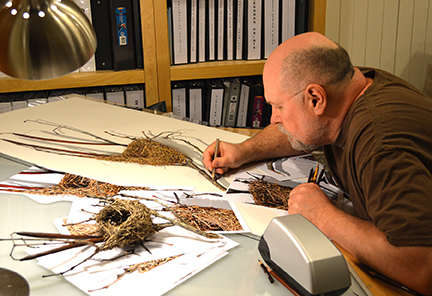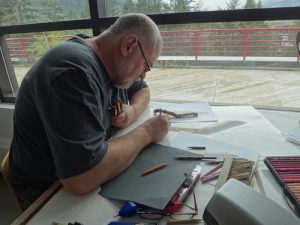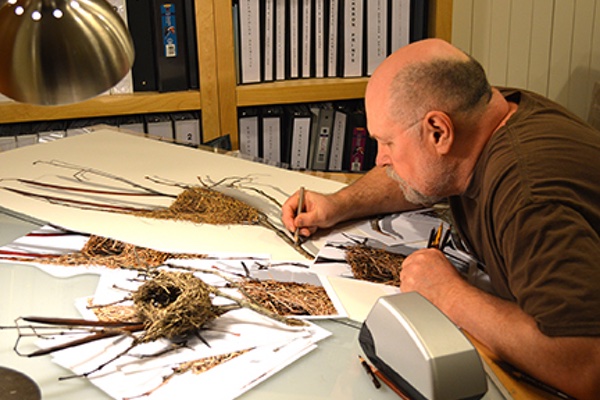Colored-Pencil Art: “I want to record this moment of existence.”
Press Interview with David Morrison
See his colored pencils drawings in The Woven Tale Press Vol. IV #3

You describe your drawings as “hyper realistic.” Is this attention to detail informed by your experience as a printmaker? If so, how exactly?
Paying close attention to detail has been a fixation my whole life. It is in everything I do. One could say I’m obsessed with perfection when I’m creating art. Therefore printmaking, a very labor-intensive media, was well-suited for me. There are many steps to get to a completed print, and every color run has to be registered exactly. Some of my prints will have up to twenty or more layers of transparent color. The depth of color is slowly built up with multiple layers of transparent color, each layer adding minuscule amounts of hue.
I can bless my mom for my obsessiveness. For example, she was totally obsessed with the soap opera General Hospital and would not miss a single episode. My family would take vacations by car and whenever we were traveling we would have to stop a find a television to watch the show at that given hour. It was totally nuts, but she could not miss an installment. In addition, she had the most amazing salt and pepper collection, amassing hundreds of pairs. I have my own collections, such as mechanical birds from the 1950’s. In addition, I see the different series of my drawings as collections and often exhibited them salon-style as collections.
My earliest drawings showed my fascination in recording and rendering the internal structure of an object. As a kid I would love to take things apart and see how they work, only to never to get them back together. I loved looking at how things where constructed.
“Look deep into nature, and then you will understand everything better.” Albert Einstein
Drawing nature, for me, is discovering the life of an item. The details of that life are portrayed where it shows its age, scars and other damage marks made by insects or disease. I want to record this moment of existence. I want to show how incredible these objects are by capturing some of details through careful observation. After experiencing the drawings, my hope is to reintroduce the viewer to seeing and how remarkable this observation can be, to allow the viewer to realize what I see in such a common object as a stick.
I love this quote by Liz Garvey, my gallery owner, when I sent her a series of my new sticks drawings:
“Congratulations on this exquisite body of new work; and for helping me see the extraordinary in the ordinary.”
My intent is to capture in my drawings all the minute details of nature that I’m capable of drawing. Each drawing is a learning process for me about how nature impacted each object. Learning to see and depicting color, shapes and marks on a sheet a paper keep me highly motivated. Visual expression is an art for me constantly challenging my perception.

Attention to detail is apparent in both your drawing and prints–there is a precision about your work that is quite remarkable. What is it about this attention to detail that seems to motivate you more than the gestural, or the spontaneous of let’s say, abstract expressionism?
I have always been fascinated with detail, curious about how things are made and formed. My earliest drawings show my attention to observing and recording the meticulous information of a subject matter. Drawing was a way of examining every part of an object, how it was formed and how it was changed with time. The challenge was how to record what my eye was seeing to a flat sheet of paper. I love looking at things. I have always been a very detail-oriented person, but I also love the spontaneous gestural mark. Trying to capture a fraction of the detail of simple stick is overwhelming. Each time I start a drawing, it’s relearning the process over and reinventing it. This is what keeps me motivated and constantly searching for better color pencil blending techniques. Nature is incredible when you really start to look at it. I strive to make each drawing better than the last.
Wassilly Kandinsky (1866 – 1944)
‘Drawing instruction is a training towards perception, exact observation and exact presentation not of the outward appearances of an object, but of its constructive elements, its lawful forces-tensions, which can be discovered in given objects and of the logical structures of same-education toward clear observation and clear rendering of the contexts, whereby surface phenomena are an introductory step towards the three-dimensional.’
Can you explain what you mean when you refer to your drawings as “an illusion of the actual reality?”
For me drawing is an illusion of reality. Every drawing is an abstraction. Drawing is simply marks, shapes and values recorded on a sheet of paper. These marks are form together to create a realistic rendering of an object. The handing of the color along the edges of the object, along with the shadow, gives the illusion the object is three dimensional, when really it’s a flat image on paper. When I draw I use a headband magnifier and I’m quite close to the paper’s surface. This makes the shapes and forms of the drawing appear as a world of abstract color and texture.
You began your career with an MFA in printmaking, and you are a professor of printmaking. How did you initially arrive at printmaking as your focus, and specifically stone lithography?
My first love has always been drawing. Before 2000, university’s art departments did not offer a drawing major. I went to a community college for two years (Iowa Western Community College) and met a wonderful eccentric artist and mentor Nick Chiburis. He advised me that printmaking was extension of drawing. Nick introduce to Lloyd Menard at The University of South Dakota. Lloyd introduced me to stone lithography. One of the visiting artists at that school was Wayne Kimball, also a lithographer. He became my mentor. I then was totally addicted to media. We would need many pages to tell my history with lithography, though all its pains and joys.
How and when did you transition from printmaking to drawing, and to the medium of colored pencils?
For me printmaking is an extension of drawing. You are basically drawing on a lithography stone, processing it and making prints of the drawing. I have always done color pencils drawings of the subject before doing the print. They both work hand to hand.
When you began these drawings, were you initially inspired by the medium of colored pencil or by your subjects, primarily ones from nature? How might one have informed the other?
The big change came when my wife and I purchased a home with one and three-fourths of an acre. On the property there were huge sycamore trees along with a variety of others trees. After storms we routinely picked up fallen sticks and branches. The sycamores would also shed their bark, creating these beautiful landscapes of bark fragments around the tree. Usually I would just mow over the bark. Then one day I started looking closely at the bark. I notice how magnificent the shapes of the bark was and how its showed the life and history of the tree. Likewise, I now look closely at the fallen limbs as they are gathered up, selecting the more interesting ones to be source material.
Drawing with colored pencils is very intimate for me, as the pencil became an extension of my hand. The slightest variation in pressure and sensitivity can be recorded. I like the idea the pencils are relatively inexpensive compare to paints. They are available to almost everybody and most people have had experience using them. My idea is to take the common and give it iconic status. This applies to using the techniques in a highly refined matter not usually associated with the sketchy association of color pencil.
How exactly do you achieve, with pencil, your effect–How much is it a combination of technique and actual medium, including your choice of paper? (Describe your process.)
The process starts with photographing the objects. I like to work from three photographs (light, medium and dark value) and the actual object. The drawing is transfer to the paper. I prefer Stonehenge paper from Legion Paper, as it is smooth and tough. I then cover the paper with an airbrush frisket film that has an opening slightly larger than the drawing. The frisket film protects large amounts of white paper during the drawing process.
I use Berol Prismacolor Premier Pencils. They make about 120 colors. The process usually involves starting with the base color and layering colors to achieve the color tone I want. Then I blend the colors with a lighter color close to shade that I am working with. The pencils are very soft which helps blend the color, but difficult to keep sharp. I work with a sharpener next to me. Usually I develop the values first by layering and blending the colors to form the under drawing. Then I layer more colors, while working on the sharpness of the details the object. Each square inch will usually take three to four hours to finish. I work with a headband magnifier that magnifies the area three and ½ times, and my nose is four inches from the drawing.
Do you draw primarily from life or photos or both?
I draw both from life and photos. The natural objects are constantly changing. The photos record a moment in their existence at that period of time. Plus, the photographs record the shadows I desire. I work from three photos of different exposures: one very light, the correct exposure and an over exposed photo. By using these different photos I can adjust the values as I draw and see what is happening in the shadows and lighter areas.
What are you working on in your studio right now?
Right now I’m working on gathering resource materials for a new series of drawings of the mid-section of sycamore or other common trees. My plan is to focus on the midsection of trees, with the intent of using a long narrow format similar to that found in Chinese bamboo scroll painting. When I teach drawing to college students I show examples of Chinese scroll painting and talk about Xie He’s six principles of Chinese painting. The drawings would examine the growth and life of the body of the tree. I’m also working on a series of drawing of branches that have been on the ground for period of time. The barks of these branches are covered with moss, lichens and mushrooms.
What does your typical studio day look like?
My typical studio day starts at 7:00 in the morning, drawing for four hours before breaking for lunch. I start back at 1:00, drawing to about 4:00 p.m. Then I will be back at the drawing table from 7:00 to 10:00 at night. Drawing for this length of time is a meditative process for me.
What other artists’ works do you have or wish you could have displayed in your own home?
I love the work of Ron Isaacs. In his artist statement he quotes a statement from Claes Oldenburg, in which he declared the harder he looked at a thing, the more mysterious it became, which I find equally true. We have a piece of his Isaacs’ Crow Series hanging in our living room. I’m saving up my money to purchase a Jennifer Mastre color pencil sculpture. They are brilliant. I just saw a Martin Puryear show at the Morgan in New York City. His sculpture, prints and drawings are amazing; I would love to own a piece by him.

